
BioMed Central
Page 1 of 8
(page number not for citation purposes)
Cough
Open Access
Research
Measuring cough severity: Perspectives from the literature and
from patients with chronic cough
Margaret Vernon*1, Nancy Kline Leidy†1, Alise Nacson†1 and Linda Nelsen†2
Address: 1United BioSource Corporation, Bethesda, MD, USA and 2Merck & Co Inc, North Wales, PA, USA
Email: Margaret Vernon* - margaret.vernon@unitedbiosource.com; Nancy Kline Leidy - nancy.leidy@unitedbiosource.com;
Alise Nacson - alisenacson@yahoo.com; Linda Nelsen - linda_nelsen@merck.com
* Corresponding author †Equal contributors
Abstract
Background: In order to assess severity of cough from patients' perspectives and capture the
effects of treatment in clinical trials, a measurement tool must show evidence of validity and
reliability. The purpose of this study was to characterize cough severity from patients' perspectives
as the initial step in the development of a new patient-reported outcome (PRO) measure for use
in clinical trials.
Methods: This focus groups study included patients with clinician confirmed chronic cough
recruited from a large internal medicine clinic in the US. A semi-structured focus group guide was
designed to elicit information about patients' experiences with cough severity and their
characterization of symptoms. The focus group data were coded to identify concepts and
terminology of cough severity.
Results: Three focus groups were conducted [n = 22; 6 male; mean age 66.1 (± 12.9)]. Etiology
included GERD, asthma, bronchitis, post-nasal drip, and other. Three domains of cough severity
were identified: frequency, intensity, and disruption. In addition to a single cough, participants in all
focus groups described coughing in uncontrollable paroxysms they called "fits," "bouts," "spells," or
"episodes." The urge to cough, described as an important sign of impending cough, was considered
a component of cough frequency. Participants also described daytime activity and nighttime sleep
disruption as an indication of cough severity. Finally, participants described variability in cough
severity.
Conclusion: Results suggest that patients describe cough severity in terms of frequency, intensity,
and disruptiveness, indicating these 3 domains should be addressed when evaluating cough severity
and outcomes of treatment.
Introduction
Chronic, persistent cough is a frustrating and bothersome
symptom for many adults; loss of sleep, exhaustion, irrita-
bility, urinary incontinence, cough syncope, social disa-
bility, and inability to perform daily activities are some of
the negative outcomes associated with this condition [1].
Many persons experience chronic cough secondary to
another medical condition, such as COPD, asthma, rhi-
nosinusitis, GERD, post-nasal drip, or unknown etiology.
Chronic cough has been defined as cough present for
Published: 19 March 2009
Cough 2009, 5:5 doi:10.1186/1745-9974-5-5
Received: 19 November 2008
Accepted: 19 March 2009
This article is available from: http://www.coughjournal.com/content/5/1/5
© 2009 Vernon et al; licensee BioMed Central Ltd.
This is an Open Access article distributed under the terms of the Creative Commons Attribution License (http://creativecommons.org/licenses/by/2.0),
which permits unrestricted use, distribution, and reproduction in any medium, provided the original work is properly cited.

Cough 2009, 5:5 http://www.coughjournal.com/content/5/1/5
Page 2 of 8
(page number not for citation purposes)
more than 8 weeks; subacute cough is generally consid-
ered to last between 3–8 weeks, and may be the result of
unresolved symptoms of respiratory infection [2,3].
Cough is a common symptom and a frequently stated rea-
son for health care visits [2].
When assessing the effectiveness of new therapies for
reducing cough symptom severity in a clinical trial setting,
patient reported outcomes (PROs) are an important
methodological tool for evaluating treatment effective-
ness. Whether selecting an existing instrument or develop-
ing a new PRO instrument, qualitative research in the
form of interviews or focus groups is important to ensure
that the content of the instrument is consistent with
patients' experiences and that the concepts measured by
the instrument include the elements that patients' con-
sider most important about a condition or a treatment
intervention in order to enhance measurement precision
[4]. Quantitative research is critical to ensuring that the
instrument is suitably reliable and valid to be able to
detect treatment effects [5].
A recent literature review was conducted to determine
PROs that have been used and are publicly available to
measure cough symptom severity in chronic and subacute
cough patient populations, as well as to evaluate whether
any of the instruments uncovered in the review have doc-
umented evidence of good psychometric properties [6].
Articles were reviewed that included PRO measures as pri-
mary or secondary endpoints in clinical trial settings. In
addition, articles were reviewed that provided informa-
tion surrounding the development or measurement prop-
erties of PROs designed to evaluate cough symptom
severity. Particular attention was given to the content and
design of PRO cough measures (item content, recall
period, mode of administration, response scale, response
anchors). Included in the literature review were articles
that were published in English between 2002 and 2006.
Eighteen papers met the review inclusion and exclusion
criteria and were reviewed in full.
Three validated instruments were found that evaluate
health-related quality of life (HRQL) in cough popula-
tions [e.g., the Leicester Cough Questionnaire (LCQ) [7];
the Cough Specific Quality of Life Questionnaire (CQLQ)
[8]; and the Chronic Cough Impact Questionnaire
(CCIQ)[9]. These questionnaires have multiple items and
domains and address the impact of cough on various
aspects of health-related quality of life, including physical,
psychological, and social domains, and ask patients to
reflect on the effect cough has had on their lives. As such,
they are useful to capture the impacts of cough symptoms,
but are not suitable to evaluate the severity of the symp-
tom per se. No validated PRO measures of cough symp-
tom severity were identified within the published
literature. Further, no articles detailing qualitative work to
support the content of cough symptom severity measures
were found. Among the cough symptom severity meas-
ures used in clinical trial settings, there were no two symp-
tom severity measures that were exactly alike in content or
design.
Content of these instruments provide insight into the
aspects of cough severity considered important from a
clinical trial perspective. Six of the studies reviewed
included a measure that assessed frequency of individual
coughs or frequency of 'periods' or 'bouts' of coughing
[10-15]. In addition, six studies measured nighttime
coughing or sleep disturbance (awakening) due to cough-
ing [10-15]. Several studies used measures that assessed
daytime disruption due to coughing (e.g., cannot perform
most usual activates due to coughing) [8,10,12-15].
Finally, several studies reviewed included measures that
assessed intensity of cough (e.g., distressing cough; chest/
abdominal pain) [11-15].
In terms of measurement design, subjective cough symp-
tom items uncovered in the literature review often had 10-
point Visual Analogue-type response scales (VAS) with
two descriptive terms to anchor the extreme values
[7,13,14,16-19]. For example, the phrases "no cough" to
"most severe cough" have been used as anchors for sever-
ity items, among others. Items to evaluate cough were
often administered as pen and paper patient-completed
daily diaries with 24-hour recall periods [17].
Findings from the literature review suggested that con-
cepts to consider when evaluating cough severity include
both the frequency and intensity of cough. These concepts
were often measured daily with a single item using a VAS-
type response scale. Although common concepts and
design elements were identified, no standard measure is
available for capturing cough symptom severity. An
instrument based on sound science and the principles of
instrument development could result in a tool with
greater precision and sensitivity of measurement, provid-
ing a better understanding of the magnitude and pattern
of cough in a variety of patients, and more accurately cap-
turing the effects of treatment on this important symptom
in a clinical trial setting. Because this is a phenomenon
experienced by the patient, the instrument should be con-
sistent with patients' descriptions of the important facets
of cough symptom severity, as well as the words they use
to describe this symptom and their day-to-day cough
experiences in order to ensure that the tool has content
validity [4]. No qualitative evidence was found in the lit-
erature review that indicated that the concepts included in
the cough symptom severity items used are consistent
with patients' descriptions of symptoms or symptom
experience.

Cough 2009, 5:5 http://www.coughjournal.com/content/5/1/5
Page 3 of 8
(page number not for citation purposes)
The purpose of this study was to evaluate patients' per-
spectives on cough symptom severity by conducting focus
groups with chronic cough patients with the end goal of
selecting, adapting, or developing a new cough severity
instrument that would be consistent with patients' experi-
ences and thus increase measurement validity, precision,
and standardization of cough symptom severity. Specific
objectives of the current research were: 1) to gather infor-
mation about patient perceptions of the attributes of
cough, 2) to identify key subjective issues and concerns
related to chronic and/or subacute cough severity and 3)
to identify the language and terminology patients use to
describe their cough, with a focus on cough provocation,
intensity, frequency, and periodicity.
Methods
Design
This cross-sectional, qualitative study included 3 focus
group sessions with participants who had a diagnosis of
chronic cough with various etiologies. Participants for the
focus groups were recruited by a large internal medicine
clinic in suburban Washington, DC. Eligible participants
were identified through chart review and were screened to
ensure that they met the study entry criteria. They were eli-
gible to participate in the chronic cough group if they had
a dry, non-productive cough for ≥ 8 weeks due to asthma,
GERD, or some other unknown condition. Participants
with moderate to severe COPD were excluded given that
cough associated with this condition is often productive
and may only be one symptom among other respiratory
symptoms. Participants were ineligible if they were cur-
rently taking antibiotics, or medications known to cause a
cough (e.g., ACE Inhibitors), if they had allergic rhinitis,
congestive heart failure, or if they had a current upper res-
piratory tract infection. Inclusion/exclusion criteria
allowed for the recruitment of subacute cough partici-
pants in addition to chronic cough participants but no
subacute cough participants were enrolled in this study.
Study Procedures & Focus Group Guide
The focus groups were held at a focus group facility and
moderated by researchers trained in qualitative methods
and focus group moderation. All participants provided
written informed consent prior to the focus group discus-
sions. With the consent of participants, all discussions
were audio-recorded and observed by members from the
research team through a one-way mirrored window. The
moderator followed a pre-scripted semi-structured focus
group guide when leading the discussion, and participants
were encouraged to discuss their experiences with each
other. The focus group guide was designed to elicit infor-
mation on the patient terminology and experiences spe-
cifically related to cough, including descriptions of cough,
severity of cough, frequency of cough, cough at night, var-
iability in frequency of cough, concept of episode, sensi-
tivities (triggers of cough), as well as variability in cough
severity. Specifically, the group discussions were opened
with very general questions (Please describe your cough).
As participants began to discuss and describe more spe-
cific attributes of their cough, themes that emerged were
followed up on with neutral probes using the language
that participants used. For example, after the concept of
frequency of cough was brought up by at least one person,
the group was asked as a whole to describe the frequency
of their cough using the terminology that was already
spontaneously discussed. After at least one person
described coughing at night (and/or disruption caused by
nighttime cough), the group was asked to discuss experi-
ences with coughing at night. In this way, the guide started
with very general questions and themes and terminology
were allowed to emerge organically. The moderator did
not introduce words and themes that had not been previ-
ously used in the discussion.
The primary purpose of the study was to explore patients'
experiences with cough symptom severity, including
cough frequency, intensity, provocation, and periodicity.
Each session lasted for approximately 90 minutes. At the
conclusion of each discussion, participants were asked to
complete a brief sociodemographic and clinical question-
naire and were remunerated $50 for their participation.
Qualitative Analysis Approach
A content analysis approach was used to analyze the data
(transcripts, field notes and audio-recordings) from the
focus group sessions. The focus groups were audio
recorded and transcribed; verbatim transcripts were ana-
lyzed using ATLAS.ti qualitative data analysis software
[20]. General themes related to cough severity, issues, and
concerns about chronic cough and side effects of treat-
ment were identified and coded in the focus group tran-
scripts. Each transcript was independently coded by two
researchers, and codes were compared. When differences
in coding occurred, codes were reconciled through collab-
orative review and re-reading of each focus group tran-
script. Themes that emerged from the data were organized
in order to develop a conceptual model of cough severity.
Results
Sample
A total of 22 chronic cough participants were included in
the focus group discussions. Saturation, or the point at
which no substantially new information continues to
emerge, was reached for cough symptoms upon comple-
tion of the third focus group, thus three focus groups were
conducted [4]. The average age of study participants was
66.1 ± 12.9 years, and 72.7% of the sample was female.
Among study participants, all were Caucasian and more
than half the sample reported a household income greater
than $60,000 per year. The most common etiologies of

Cough 2009, 5:5 http://www.coughjournal.com/content/5/1/5
Page 4 of 8
(page number not for citation purposes)
chronic cough as reported by patients were gastroesopha-
geal reflux disease (GERD) (n = 7), asthma (n = 5), bron-
chitis (n = 4), and post-nasal drip syndrome (n = 4). Other
causes of chronic cough reported by patients included irri-
tant exposure, post-infectious cough, and mild chronic
obstructive pulmonary disease (COPD). Most partici-
pants (86.7%) reported having completed diagnostic tests
for their cough.
Descriptive statistics of the sociodemographic and clinical
questionnaire showed that almost all of the participants
reported coughing while performing daytime activities
and all but three participants reported some coughing
while trying to sleep at night. All participants had experi-
enced their cough for greater than 8 weeks, and most of
the participants (81.8%) reported experiencing their
cough for greater than one year and 31.8% of participants
rated their cough severity as "very severe;" 50% rated their
cough severity as "moderate;" 13.6% considered their
cough to be "mild;" and 4.6% considered their cough to
be "very mild." With respect to treatment, most of the par-
ticipants (n = 17) reported taking prescription medica-
tion, while others reported the use of over-the-counter
treatments (n = 8) and/or herbal or other home remedies
(n = 7).
Focus Group Discussion Results
Review of the focus group transcripts identified the emer-
gence of three major themes which were used to develop
the coding dictionary and used in qualitative analysis.
First, participants in all groups discussed triggers of and
treatments for cough at length. For example, participants
discussed such triggers as spicy food, air conditioning, and
perfumes, all of which were reported to provoke cough-
ing. In addition, participants in each group were eager to
discuss a variety of treatment options and homeopathic
remedies, including prescription treatments, over-the-
counter treatments, and behavioral modifications. While
triggers and treatments were extensively discussed, this
report does not summarize these topics in-depth as they
do not pertain to the description of the attributes of cough
severity. Secondly, participants described the attributes of
cough and the characteristics of cough in terms of both inten-
sity (e.g., deep cough) and frequency (e.g., constantly).
Finally, in discussions about cough intensity and fre-
quency, participants often discussed disruption of daily rou-
tines or activities and disruption to nighttime sleep. In the
results sections that follow, attributes and characteristics
of cough are discussed first. The final section discusses the
quantity and quality of disruption to patients' daily rou-
tines and activities as well as disruption of nighttime sleep
due to cough. It should be noted that in order to clearly
present the information patients provided, major concept
themes are discussed separately in the results sections that
follow. During the focus groups, concepts and themes
that we discuss in separate sections for clarity of presenta-
tion were often discussed jointly and were highly related
for the participants.
Description of Cough Intensity
At the beginning of the focus group sessions, participants
were asked to describe their cough. A variety of words
were offered to describe the intensity of the cough: hack-
ing, deep, strong, harsh, intense, deep, and barking.
When describing experiences with coughing, participants
discussed physical discomfort and physical reactions such
as pain or vomiting resulting from a particularly intense
cough:
...I keep coughing, and that's when your throat starts to
hurt.
I will cough, and cough, and cough, and cough until I basi-
cally have triggered, you know, trying to vomit in my stom-
ach kind of thing.
I've gotten to that point where I'm coughing, I mean, the
diaphragm, the rib cage, umm, is painful.
Participants also offered descriptions of other qualities of
their cough, including whether the cough was productive
or non-productive. The majority of participants in this
sample described their cough as non-productive.
Mine is very hacking, and it's not intense or deep, and
nothing comes up. It's not productive.... It's dry hacking.
The Urge to Cough & the Coughing Episode
When describing their cough, participants also discussed
two experiences that were related to coughing but differed
from their description of an individual cough: the sensa-
tion of having the urge to cough and the experience of
having coughing fits, episodes, or bouts. Urge to cough
was generally discussed as the antecedent to a cough, and
most often described as a tickling sensation in the throat.
A coughing fit or episode was described as an uncontrol-
lable bout of coughing lasting for more than one or two
individual coughs. These two experiences were highly
related to the experience of coughing for participants in
these focus groups. Urge to cough was described in the fol-
lowing ways:
When I wake up in the morning, I can feel-if I feel a tickle
back in the back of my throat I know ultimately I'll end up
coughing during the day at some point or another.
I get this tickle and I have to cough, you know, and it's all
day.

Cough 2009, 5:5 http://www.coughjournal.com/content/5/1/5
Page 5 of 8
(page number not for citation purposes)
Many of the participants described having coughing par-
oxysms, which were termed fits, bouts, or episodes. These
episodes were often described in terms of coughing
uncontrollably for some duration of time. While there
was perhaps some ability to control or fight off of the urge
to cough or an individual cough, there was little control
over the cough during an episode:
I have it under control with the medication, but I still get
some fits that usually last five minutes, and they're rather
intense, uh, in coughing.
...I had a coughing jag at work one day that was totally
embarrassing. I couldn't stop. ...occasionally I'll have a real
episode, but it's more just every once in a while.
...but normally during the day I'll have just attacks of four,
five, or six coughs and then it will clear up...
Frequency of Urge, Cough, and Episode
In addition to discussing the qualities of the urge to
cough, the cough, and the episode, participants also dis-
cussed the frequency of their urges to cough, coughing,
and coughing episodes. For participants in these focus
groups, the frequency of the urge, the amount of cough-
ing, and the number of coughing fits or episodes that they
experienced on any particular day was related to how 'bad'
or severe their coughing was for that day. As one partici-
pant noted, "So frequency is an issue and so is how bad,
how severe the cough is...so it does fall within some con-
tinuum." In addition, participants also discussed how
often they experienced coughing during the night. Sample
quotations representing this concept are as follows:
Mine's just all the time. I cough all the time.
For me it would be intermittent coughing throughout the
day.
I will cough, you know, like occasionally, but not continu-
ously unless I get something more severe.
Sometimes I can't sleep at all night. I have to get up and go
get in a chair, because whatever is coming out of my head
or my throat is sitting in this bronchial tube down there,
and it's messing up everything. And it's continuous.
Umm, I pretty much cough all day and all night, but I've
taken some medication.
Uh, yes, uh, I wake up at least by midnight and have a
series of coughs and then about 3:00.
I'm not coughing at all and, you know, it could be months
before I get another cough, but when I get a cough, the fre-
quency is close to ten and how bad it is can be a ten.
While many people describe the frequency of their cough-
ing during the day and at night with descriptive frequency
terms (continuous, constantly, intermittent, occasional, a
little), participants in all 3 focus groups reported that they
could not accurately account for the exact number of
coughs that they had over a given time period:
I don't really know how often I cough, 'cause I'm oblivious
to it many times. My wife will tell me that I'm on the tele-
phone coughing. So, that's part of probably just being not as
aware sometimes as other people would be.
I don't think anyone can tell you how many times they
cough a day. You're asking about frequency. I really don't.
And sometimes I'm coughing, I don't even realize it. You
know.
Finally, participants also described the frequency of their
urge to cough as well as the frequency of episodes:
...You should just stop coughing. Just stop. Don't do it. And
I say but I get this tickle and I have to cough, you know, and
it's all day.
Five, six, seven, eight [episodes]. I mean this is a really good
time right now in here.
It's very infrequent episodes.
Variability in Frequency
Many participants reported that the amount of coughing
that they experience varies both over the course of one day
as well as from day to day. For example, some of the par-
ticipants reported that they experience more frequent
coughing in the morning, some reported more frequent
coughing in the afternoon, and some reported that they
cough more frequently at night or that the cough comes
back at night. However, among this group of participants,
there were no clear patterns in terms of when during the
day participants were likely to experience more or less
coughing. Participants discussed more variability in fre-
quency from day to day than within one day. Participants
said things like:
Some days are...much worse than others.
No, I think everyday, you know, everyday is different.
...Some days I don't have anything like that, and all of a
sudden I might have one [episode].
Daytime Activity Disruption
Participants anchored the severity of their cough to the
disruption it caused, including social disruption that they
experience due to their frequent cough, which included

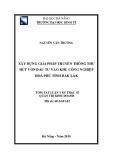


![PET/CT trong ung thư phổi: Báo cáo [Năm]](https://cdn.tailieu.vn/images/document/thumbnail/2024/20240705/sanhobien01/135x160/8121720150427.jpg)
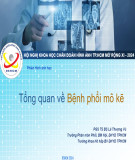
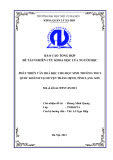

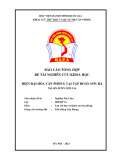
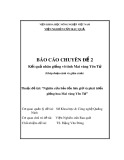






![Báo cáo seminar chuyên ngành Công nghệ hóa học và thực phẩm [Mới nhất]](https://cdn.tailieu.vn/images/document/thumbnail/2025/20250711/hienkelvinzoi@gmail.com/135x160/47051752458701.jpg)









